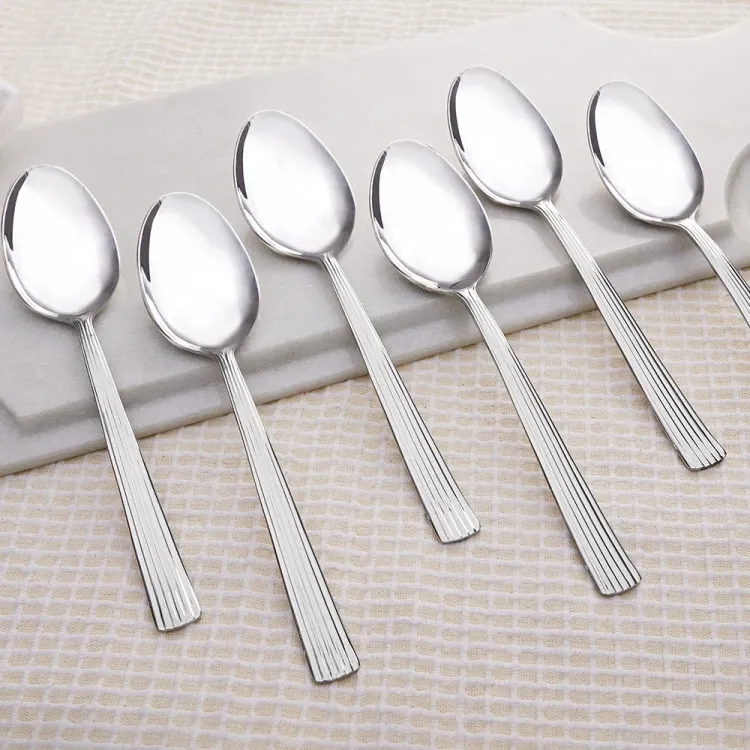Spoons: Timeless Tools with a Storied Past...!!!
Spoons are among the most essential and versatile utensils in the culinary realm, used for eating, serving, and cooking. These simple yet indispensable tools have evolved over centuries, taking on various shapes and designs to suit different purposes.

Historical Journey of Spoons
The history of spoons dates back to prehistoric times when early humans used shells, stones, and pieces of wood to scoop and consume food. The term "spoon" comes from the Old English word "spon," meaning a chip of wood. Early spoons were primarily made from wood, bone, or horn and were often crafted by hand.
As civilizations progressed, spoons began to be made from metals such as bronze, silver, and gold. Ancient Egyptians, Greeks, and Romans used metal spoons adorned with intricate designs and engravings. In medieval Europe, spoons became symbols of wealth and status, with elaborate silver and gold spoons being used by the nobility.
During the 18th and 19th centuries, the production of spoons became more standardized with the advent of industrialization. This period saw the mass production of spoons made from stainless steel, which became the most common material due to its durability and affordability. Today, spoons are made from a variety of materials, including plastic, ceramic, and bamboo, catering to different needs and preferences.
Varieties of Spoons
Spoons come in various shapes and sizes, each designed for specific purposes. Some common types of spoons include:
-
Teaspoon: A small spoon typically used for stirring tea or coffee and measuring small quantities of ingredients in cooking.
-
Tablespoon: Larger than a teaspoon, this spoon is used for serving and measuring larger quantities of ingredients.
-
Soup Spoon: Characterized by its round, deep bowl, a soup spoon is designed for consuming soups and broths.
-
Dessert Spoon: Slightly smaller than a tablespoon, a dessert spoon is used for eating desserts such as puddings and ice cream.
-
Serving Spoon: Larger and sturdier than regular spoons, serving spoons are used for dishing out food from serving bowls and platters.
-
Slotted Spoon: Featuring slots or holes in the bowl, a slotted spoon is used for draining liquids while serving solid foods.
-
Wooden Spoon: Commonly used in cooking, wooden spoons are gentle on cookware and ideal for stirring and mixing ingredients.
-
Measuring Spoons: These spoons come in sets of different sizes and are used for precisely measuring ingredients in cooking and baking.
-
Grapefruit Spoon: With a serrated edge, a grapefruit spoon is designed to scoop out the flesh of citrus fruits.

Uses of Spoons
Spoons are versatile tools with a wide range of uses in both culinary and non-culinary contexts. Some common uses of spoons include:
-
Eating: Spoons are essential for consuming liquid and semi-liquid foods such as soups, stews, porridges, and desserts.
-
Serving: Serving spoons are used to transfer food from serving dishes to individual plates, making them indispensable at meals and gatherings.
-
Cooking: Wooden spoons and metal spoons are commonly used in cooking for stirring, mixing, and sautéing ingredients. Slotted spoons are ideal for lifting and draining food from boiling water or frying oil.
-
Measuring: Teaspoons and tablespoons are used as standard units of measurement in recipes, ensuring precise ingredient quantities for successful cooking and baking.
-
Decoration: Ornate spoons made from precious metals or decorated with intricate designs are often used as decorative items or collectibles.
-
Ceremonial and Cultural Uses: In some cultures, spoons hold symbolic and ceremonial significance. For example, wooden spoons are traditionally given as gifts in Welsh culture, symbolizing love and affection.
Cultural Significance of Spoons
Spoons hold cultural and symbolic importance in various societies around the world. In Welsh culture, "love spoons" are intricately carved wooden spoons given as tokens of affection. These spoons often feature symbolic designs, such as hearts, keys, and knots, representing love, security, and eternity.
In some Asian cultures, spoons are used in traditional tea ceremonies and rituals. For instance, the Japanese tea ceremony involves the use of a chashaku, a bamboo spoon used to scoop powdered green tea (matcha) into a tea bowl.
Spoons also feature prominently in folklore and literature. For example, the phrase "born with a silver spoon in one's mouth" originates from the practice of giving silver spoons to wealthy infants as christening gifts, symbolizing privilege and prosperity.
Modern Innovations
In recent years, there have been various innovations in spoon design and functionality. For example, ergonomic spoons with specially designed handles are available for individuals with limited hand mobility. Collapsible and portable spoons have become popular for outdoor activities such as camping and hiking.
Moreover, eco-friendly spoons made from sustainable materials like bamboo and biodegradable plastics have gained popularity as environmentally conscious alternatives to disposable plastic spoons.
Spoons are essential tools that have evolved over millennia, serving a wide range of practical and symbolic purposes. From their humble beginnings as basic scooping tools to their modern-day forms, spoons have become integral to daily life, culinary practices, and cultural traditions. With their diverse designs and uses, spoons continue to be indispensable utensils that enhance our dining and cooking experiences.
What's Your Reaction?

















